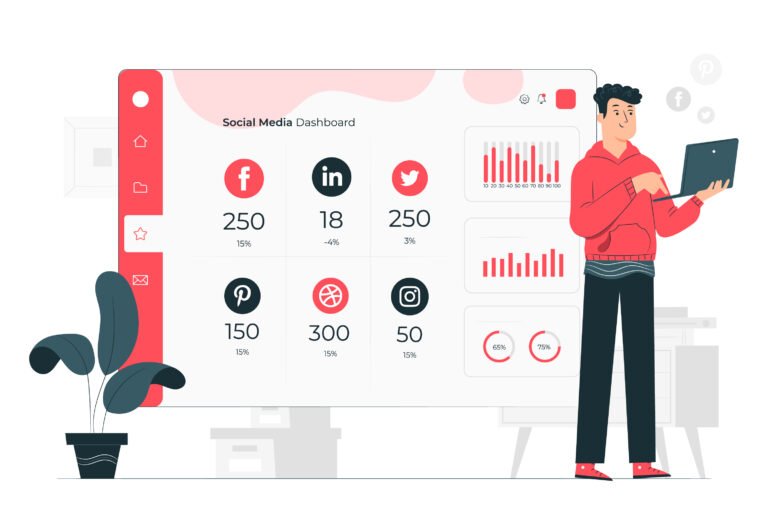1. What Are Engagement Metrics?
Engagement metrics refer to the various ways users interact with your social media content. These interactions can include likes, comments, shares, saves, clicks, and views. Essentially, engagement metrics are the digital “signals” that show how much interest or value your content generates among your audience. Tracking these metrics helps creators, marketers, and brands understand what resonates with their followers and how effectively their content is performing.

Why Do Algorithms Care About Engagement?
Social media algorithms are designed to prioritize content that keeps users active and engaged on the platform. When your post receives high engagement, the algorithm interprets this as a sign that your content is relevant and valuable to your audience. As a result, it boosts the visibility of your post, showing it to more people beyond your immediate followers. Algorithms aim to create a personalized experience by serving users content they’re more likely to interact with, making engagement a critical factor in expanding reach and growing your online presence.
2. Key Engagement Metrics Explained
Likes and Reactions
Likes and reactions are the most basic form of engagement and often the first indicator of how well your content is received. While they show general approval, they don’t require much effort from the user, so algorithms weigh them accordingly but consider other forms of engagement too.
Comments and Replies
Comments require more effort and thought, signaling stronger interest or emotional connection. Algorithms tend to value comments higher because they indicate active conversations around your content, which keeps users on the platform longer.
Shares and Retweets
When users share your content with their own networks, it greatly increases your reach and signals to the algorithm that your content is valuable enough to recommend. Shares are among the highest-impact engagement metrics for boosting visibility.
Saves and Bookmarks
Saves or bookmarks indicate that users find your content useful or worth revisiting. This form of engagement shows deeper interest and helps your content get prioritized by algorithms, especially on platforms like Instagram and Pinterest.
Views and Watch Time
On video platforms like TikTok, YouTube, or Instagram Reels, total views and how long users watch your videos (watch time) are crucial. Longer watch times suggest your content is engaging and keep the audience interested, which algorithms reward by increasing exposure.
3. How Engagement Metrics Influence Social Media Algorithms
Boosting Content Visibility
Algorithms prioritize content that receives higher engagement because it indicates that users find it interesting and relevant. When your post gets a lot of likes, comments, or shares soon after being published, the algorithm boosts its visibility by showing it to a wider audience, often extending beyond just your followers.
Ranking in Feeds and Explore Pages
Engagement metrics play a critical role in determining where your content appears in user feeds or on explore pages. Content with strong engagement is more likely to rank higher, meaning more people will see it without you needing to pay for promotion.
Impact on Content Recommendations
Many social platforms use engagement data to personalize the recommendations they serve users. For example, if someone frequently interacts with content similar to yours, the algorithm might show them your posts. High engagement improves your chances of being included in these recommendation algorithms, expanding your reach organically.
4. Platform-Specific Algorithm Behaviors
Facebook and Instagram
On Facebook and Instagram, the algorithm heavily favors meaningful interactions such as comments, shares, and saves. Posts that spark conversations or are shared among friends tend to get prioritized. Additionally, Instagram values time spent on posts and Stories, so engaging content that holds viewers longer ranks better.
Twitter and X
Twitter’s algorithm values recency combined with engagement like retweets, replies, and likes. Tweets that get quick engagement often appear higher in feeds and in the “For You” tab. Using hashtags and participating in trending conversations can boost visibility.
TikTok and Reels
TikTok’s algorithm is famously driven by watch time and user interactions like shares and comments. The more users watch your videos all the way through (or even multiple times), the more TikTok will promote your content to new viewers via the “For You” page.
LinkedIn and Professional Networks
LinkedIn emphasizes professional relevance and meaningful interactions such as comments and shares from your network. Content that sparks thoughtful discussions or offers value to a professional audience tends to rank higher in feeds and notifications.
5. Strategies to Improve Engagement Metrics
Creating Interactive Content
Use polls, quizzes, and question stickers to encourage your audience to participate actively. Interactive content invites users to engage directly, increasing comments and shares, which the algorithm loves.
Encouraging Comments and Shares
Ask open-ended questions or prompt your followers to share their opinions. Posts that spark conversation and encourage users to tag friends or share your content help boost your reach significantly.
Timing and Frequency of Posts
Posting when your audience is most active can maximize initial engagement, helping the algorithm recognize your content’s value quickly. Experiment with posting times and maintain a consistent schedule to keep your audience engaged.
Using Hashtags and Tags Effectively
Relevant hashtags can expose your content to niche audiences interested in your topic, increasing engagement. Tagging collaborators or influencers also helps expand reach through their networks.
6. Measuring and Analyzing Engagement Performance
Tools to Track Engagement Metrics
Use built-in platform analytics like Facebook Insights, Instagram Analytics, Twitter Analytics, and TikTok Analytics to monitor your likes, comments, shares, saves, and watch time. Third-party tools such as Hootsuite, Sprout Social, and Buffer also offer comprehensive engagement tracking across multiple platforms.
Interpreting Data for Better Content Planning
Look beyond raw numbers to understand what types of content resonate most with your audience. Identify trends such as which posts generate the most comments or shares and the time of day your followers engage the most. Use these insights to tailor your future content strategy for higher engagement and algorithm favorability.

7. Common Misconceptions About Engagement and Algorithms
Is More Engagement Always Better?
While high engagement is generally positive, not all engagement is equal. For example, spammy or irrelevant comments can hurt your content’s credibility. Algorithms also consider the quality and authenticity of interactions, so meaningful engagement is more valuable than sheer volume.
The Role of Fake Engagement and Its Risks
Buying followers or using bots to inflate engagement might offer a short-term boost, but platforms are increasingly able to detect fake activity. This can lead to penalties like reduced reach or even account suspension. Genuine engagement from a real audience is key to sustainable growth and algorithm success.
8. Conclusion
Recap: Why Engagement Matters
Engagement metrics are the lifeblood of social media algorithms. They signal to platforms which content resonates with audiences, directly influencing how widely your posts are distributed. Understanding and optimizing these metrics is essential for growing your reach and building a loyal online community.
Tips for Long-Term Success on Social Media
Focus on creating authentic, valuable content that encourages meaningful interactions. Consistently analyze your engagement data to refine your strategy, and avoid shortcuts like fake engagement that can harm your credibility. By nurturing genuine connections with your audience, you’ll harness the power of engagement to thrive in social media’s ever-evolving landscape.
FAQs
Q1: What are the most important engagement metrics to focus on?
While likes and reactions are important, comments, shares, saves, and watch time typically have a greater impact on how algorithms rank your content because they show deeper user interest.
Q2: How quickly does engagement affect my post’s visibility?
Engagement within the first few hours of posting is often crucial. Algorithms tend to boost content that gains traction quickly, increasing its reach.
Q3: Can I improve my engagement metrics organically without paid ads?
Yes! Creating valuable, interactive, and relevant content that encourages genuine interaction is the best way to grow engagement naturally.
Q4: Does negative engagement (like angry reactions or critical comments) affect the algorithm?
Algorithms primarily focus on the volume and type of engagement, not the sentiment. However, excessive negative interactions might impact your brand reputation even if the post gets visibility.
Q5: Are fake followers or purchased engagement effective?
No. Platforms actively detect and penalize fake engagement, which can reduce your content’s reach or result in account suspension. Authentic engagement is always more beneficial.
Read Also: Social Engagement: 9 Smart Tips for Digital Growth






